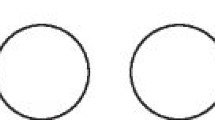Abstract
Data sources
The Cochrane Oral Health Group's Trials Register, Cochrane Central Register of Controlled Trials (CENTRAL), Medline and Embase databases were searched with no restrictions regarding language or date of publication.
Study selection
Randomised controlled trials (RCTs) or quasi-RCTs with at least a 6-month follow-up period after the intervention were included.
Data extraction and synthesis
Data extraction was undertaken independently by two review authors. The primary outcome was the reported prevalence of eruption or non-eruption of the ectopic permanent canine into the mouth following observation or intervention. Results were to be expressed as risk ratios for dichotomous outcomes with 95% confidence intervals and mean differences for continuous outcomes. Heterogeneity was to be investigated, including both clinical and methodological factors. Authors of trials were contacted to request unpublished data.
Results
Two trials (involving approximately 128 children, ≥150 palatally displaced canines) excluded from the previous version of this review were included. Both trials had serious deficiencies in their design, conduct and reporting, with the data presented being either incomplete or inconsistent. Both trials are at high risk of bias. Neither trial provides any evidence to guide clinical decision-making.
Conclusions
There is currently no evidence of the effects of extraction of primary canine teeth in 10-13-year-old children with one or two palatally displaced permanent canine teeth.
Similar content being viewed by others
Commentary
For most orthodontists, whether they work in specialist practice or in hospital, the management of ectopically erupting maxillary permanent canines occupies a significant amount of their clinical time. Although the prevalence of impacted, displaced or ectopic maxillary canines is reported as only between 1% to 3%,1,2 this can lead to dental crowding as well as movement or root resorption of neighbouring teeth and, more rarely, cyst formation.3,4 It is generally accepted that the majority (85%) of ectopic maxillary canines move palatally,5 although a more recent CT study,3 suggests the figure may be closer to 50%. Unless it is decided to leave and monitor the unerupted canine tooth, treatment will usually involve surgical exposure followed by orthodontic treatment with fixed appliances, and this may be prolonged.6 Alternatively, where it is suspected that the permanent maxillary canine is developing palatally, it is common practice to extract the deciduous predecessor. However, previous reviews,7,8 have shown that there is only limited evidence supporting this interceptive treatment.
This paper is an update of a Cochrane review published in 2009 and represents a further search of the literature. The authors identified a further 125 references since the original study. From this only two studies have been regarded as acceptable for inclusion in this update. Interestingly, both of these papers, Leonardi 2004, Baccetti 2008,9,10 were previously available and were excluded from the 2009 study. It was evident that there was some debate about their inclusion in this review. Although both were described as randomised control trials, they had previously been excluded due to deficiencies in reporting and insufficient data. It was hoped to address these problems by contacting one of the lead researchers, Dr Baccetti, but tragically he died in November 2011. Reviewers were unable to establish from the co-authors further important information concerning the design of the studies and the outcome data. It is evident from the review that both of these studies provided incomplete information about randomisation and that the groups were not matched at the outset. In addition, the outcome data were incomplete and it was also concluded that both studies were at a high overall risk of bias. This review states that neither trial provided any further evidence of the positive effects of extraction of the deciduous canine tooth in the management of palatally displaced maxillary permanent canines.
This Cochrane review thus reaches the same conclusions as its predecessor,7 and also the review carried out by Naoumova et al. in 2010.8
This latter paper went on to state that further, better controlled and well designed RCTs are required and if carried out, ideally they should also include assessment of patient satisfaction and pain experienced, as well as an analysis of the cost and side-effect of treatment.
This information does not assist the practitioner who cannot palpate one or both of the maxillary permanent canines in their 10-year-old patient. A decision whether to leave and observe the situation or to extract one or more of the deciduous canines will be made without a strong evidence base. In such a case, referral to a specialist orthodontist for an opinion at least, would be the best course of action.
Practice point
-
Any clinical examination of patients aged nine and above should involve palpation of the permanent maxillary canines if these teeth have not yet started to erupt
-
If the position of an unerupted maxillary canine is not clear, refer promptly for a specialist orthodontic opinion.
References
Grover PS, Lorton L . The incidence of unerupted permanent teeth and related clinical cases. Oral Surg Oral Med Oral Pathol 1985; 59: 420–425.
Kramer RM, Williams AC . The incidence of impacted teeth. A survey at Harlem hospital. Oral Surg Oral Med Oral Pathol 1970; 29: 237–241.
Ericson S, Kurol J . Incisor root resorptions due to ectopic maxillary canines imaged by computerized tomography: a comparative study in extracted teeth. Angle Orthod 2000; 70: 276–283.
Shafer WG, Hine MK, Levy BM . A Textbook of Oral Pathology. 2nd ed. Philadelphia: WB Saunders, 1963.
Ericson S, Kurol J . Early treatment of palatally erupting maxillary canines by extraction of the primary canines. Eur J Orthod 1988; 10: 283–295.
Iramaneerat S, Cunningham SJ, Horrocks EN . The effect of two alternative methods of canine exposure upon subsequent duration of orthodontic treatment. Int J Paediatr Dent 1998; 8: 123–129.
Parkin N, Benson PE, Shah A, et al. Extraction of primary (baby) teeth for unerupted palatally displaced permanent canine teeth in children. Cochrane Database Syst Rev 2009; Issue 2. [DOI:10.1002/14651858.CD004621.pub2]
Naoumova J, Kurol J, Kjellberg H . A systematic review of the interceptive treatment of palatally displaced maxillary canines. Eur J Orthod 2011; 33: 143–149.
Leonardi M, Armi P, Franchi L, Baccetti T . Two interceptive approaches to palatally displaced canines: a prospective longitudinal study. Angle Orthod 2004; 74: 581–586.
Baccetti T, Leonardi M, Armi P . A randomized clinical study of two interceptive approaches to palatally displaced canines. Eur J Orthod 2008; 30: 381–385.
Author information
Authors and Affiliations
Additional information
Address for correspondence: Luisa Fernandez Mauleffinch, Review Group Co-ordinator, Cochrane Oral Health Group, MANDEC, School of Dentistry, University of Manchester, Higher Cambridge Street, Manchester, M15 6FH, UK. E-mail: luisa.fernandez@manchester.ac.uk
Parkin N, Furness S, Shah A, et al. Extraction of primary (baby) teeth for unerupted palatally displaced permanent canine teeth in children. Cochrane Database Syst Rev 2012; 12: Art. No. CD004621.
This paper is based on a Cochrane Review published in the Cochrane Library 2011, issue 12 (see www.thecochranelibrary.com for information). Cochrane Reviews are regularly updated as new evidence emerges and in response to feedback, and the Cochrane Library should be consulted for the most recent version of the review.
Rights and permissions
About this article
Cite this article
O'Neill, J. Limited evidence for interceptive extraction of deciduous teeth to prevent permanent canine impaction. Evid Based Dent 14, 23–24 (2013). https://doi.org/10.1038/sj.ebd.6400918
Published:
Issue Date:
DOI: https://doi.org/10.1038/sj.ebd.6400918



